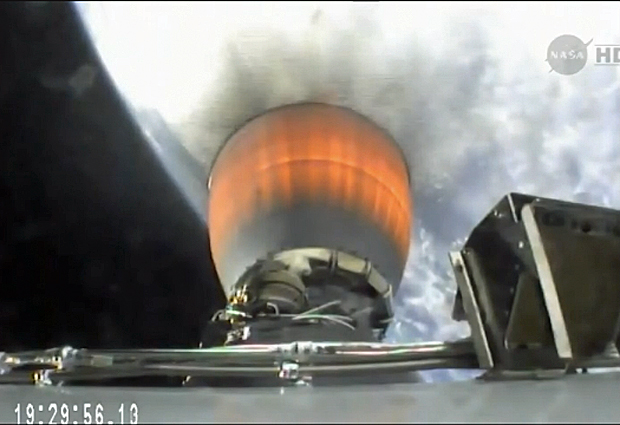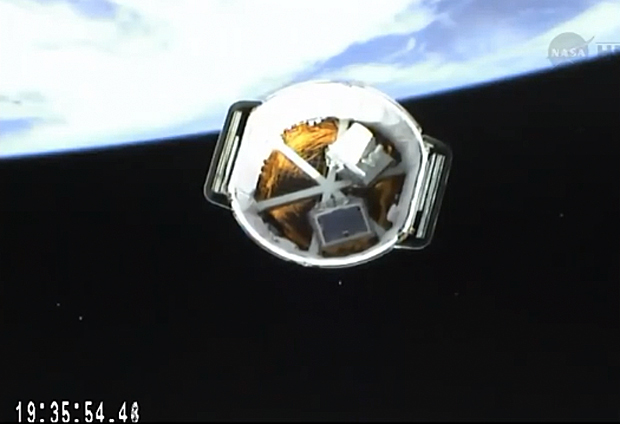SpaceX cargo ship takes off on station resupply
An upgraded SpaceX Falcon 9 rocket boosted a Dragon cargo capsule into orbit Friday, the first step in a two-day rendezvous with the International Space Station, the company's third commercial resupply mission under a $1.6 billion contract with NASA.
Running four days late because of a helium leak that grounded the rocket Monday, the Falcon 9 version 1.1 rocket roared to life at 3:25 p.m. EDT (GMT-4), roughly the moment Earth's rotation carried launch complex 40 at the Cape Canaveral Air Force Station into the plane of the lab's orbit.
Live television from cameras mounted on the 20-story-tall rocket provided views of the cloud-shrouded Florida peninsula falling away below as the booster followed a northeasterly trajectory toward the station's orbit.
Gulping liquid oxygen and kerosene rocket fuel, the Falcon's nine first-stage engines appeared to operate normally, shutting down as planned about two minutes and 41 seconds after liftoff. The first stage then fell away and the second stage's single Merlin 1D engine continued the push to orbit, its nozzle glowing cherry red in downlinked video.
The Dragon spacecraft was released from the second stage about 10 minutes and 35 seconds after liftoff, providing another spectacular view as a forward-facing camera on the second stage captured the spacecraft's departure against the limb of the Earth. A few moments later, the Dragon's solar arrays deployed as planned in another major milestone.
Elon Musk, SpaceX CEO and chief designer, said a quick look at ascent telemetry showed the Falcon 9 performed well and that other than a brief snag with a propellant isolation valve, the Dragon spacecraft was in good shape and on the way to the space station.
"Everything looks great as far as the ascent phase of the mission," Musk told reporters. "The rocket flight was perfect as far as we can tell. ... We had some slight initial challenges with Dragon with respect to enabling some of the thruster quads, but those have been resolved. So it looks like everything's good on the Dragon front."
Bill Gerstenmaier, director of space operations at NASA Headquarters, congratulated Musk and the SpaceX team for "a tremendous launch today."
"They did a lot of great work last night getting the rocket ready to go fly," he said. "With the weather conditions, it was kind of sporty for them. ... They just did a tremendous job."
If all goes well, the solar-powered Dragon will execute a series of carefully planned rocket firings to chase down the International Space Station, pulling up to within about 30 feet of the lab complex just after 7 a.m. Sunday.At that point, Expedition 39 commander Koichi Wakata and Rick Mastracchio, operating the station's robot arm and berthing system, plan to lock onto a grapple fixture and pull the spacecraft in for attachment to the Earth-facing port of the forward Harmony module.
The unpiloted Dragon spacecraft is loaded with nearly 5,000 pounds of equipment and supplies, including a new spacesuit, spare parts for suits already aboard the station, food and clothing, an experimental laser communications system and high-definition video cameras.
The equipment also includes the Vegetable Production System, or VEGGIE, hardware for growing salad-type crops in weightlessness and a set of legs for the station's humanoid robot.
In addition, the second stage of the Falcon 9 was expected to release five small satellites for a variety of research objectives, including one loaded with more than 100 tiny "picosats" measuring just 1.3 inches across. The satellites, made up of a single circuit board, are equipped with miniaturized solar panels, radio circuitry and sensors to measure the space environment.
But getting the Dragon capsule to the space station is the primary goal of the mission and if all goes well, the astronauts will open the hatch and begin unloading science equipment from the pressurized section of the spacecraft Monday.
The Dragon spacecraft also features an unpressurized "trunk" section that can be accessed by the station's robot arm. The trunk is being utilized for the first time to carry up components that will be mounted on the station's exterior.
One trunk-mounted payload is NASA's Optical Payload for Lasercomm Science, or OPALS, which will be mounted on the station's solar power truss. The OPALS hardware will test high-speed laser data transmission to and from a California ground station in a demonstration that could pave the way to improved communications with future spacecraft.
Another trunk-mounted payload includes four high-definition cameras that will be mounted on the station's exterior as part of the High Definition Earth Viewing, or HDEV, project. The cameras will be used to downlink live, streaming video of Earth while engineers monitor the effects of the space environment on the camera hardware.
SpaceX originally hoped to launch the Falcon 9 last Monday, after a decision by NASA management to proceed with the flight amid planning for a contingency spacewalk to replace a faulty computer control box in the station's solar power truss.
But SpaceX managers had to call off the launch try Monday because of a helium leak in a system used to separate the first and second stages of the Falcon 9 during ascent. The suspect hardware was replaced in a relatively straight-forward repair, clearing the way for another launch attempt.
Assuming a successful berthing by the Dragon capsule Sunday, the astronauts will make final preparations for a spacewalk Wednesday to replace the failed computer unit in the central S0 section of the lab's solar power truss.
The computer, known as a multiplexer-demultiplexer, or MDM, has been in place since S0's launch in 2002. Known as MDM EXT-2, the 50-pound "black box" commands 12 of 24 externally mounted computers, serving as a backup for commanding solar array motion, a robot arm transporter and other critical systems.
While MDM EXT-1 is working normally, NASA managers want to restore redundancy as soon as possible to protect against a subsequent failure that, without a backup in place, could disable a variety of critical systems.
NASA managers cleared SpaceX to proceed with the Falcon 9/Dragon flight after implementing protective measures that would enable near-normal operations even if MDM EXT-1 runs into problems.
A spare MDM has been stored in the Destiny laboratory module since its launch in 2001. In preparation for the replacement spacewalk, Mastracchio and Steven Swanson installed a new circuit board in the spare unit as part of a software upgrade.
During a planned two-and-a-half-hour spacewalk Wednesday, Mastracchio and Swanson plan to exit the Quest airlock, float up to the forward face of the S0 truss segment, remove the faulty MDM and install the replacement.
The old box then will be carried back inside the station for troubleshooting. Any circuit boards that don't check out will be replaced and the device will be put in storage for use as a spare if needed.
Getting the Dragon spacecraft safely into orbit was the primary objective of SpaceX's third commercial resupply mission, or CRS-3. But the company also used the launch as an opportunity to test procedures and techniques aimed at getting a Falcon 9 first stage back to Earth for recovery and eventual reuse.
The discarded first stage was programmed to attempt what amounted to a "soft landing" in the Atlantic Ocean east of Cape Canaveral, firing its engines for a controlled descent and deploying four 25-foot-long landing legs just before ocean impact.
Musk said high seas prevented recovery ships from reaching the planned impact zone and made it unlikely the rocket stage would survive splashdown, even if everything went well. But telemetry captured by a SpaceX airplane in the area showed the rocket stabilized itself and that its engines fired as planned to begin the descent.
"I would consider it a success in that we were able to control the boost stage to a zero roll rate, which is previously what has destroyed the stage, an uncontrolled roll where the on-board nitrogen thrusters were unable to overcome the aerodynamic torque and so it sort of spun up," Musk said.
"With more powerful thrusters and more nitrogen propellant, we were able to null the roll rate. So that's a bit of good news there. And, of course, we were able to show on ascent the legs don't have any negative impact and were able to come back" through the region of maximum aerodynamic stress.
Even though he did not expect to recover the spent stage this time around, "we're really starting to connect the dots of what's needed," he said. "There are only a few more dots that need to be there to have it all work. I think we've got a decent chance of bringing a stage back this year, which would be wonderful."
If SpaceX eventually perfects a recovery system, future rocket stages could be guided to nearby landing sites for refurbishment and reuse, dramatically lowering costs compared to traditional throw-away boosters.
This is the third commercial resupply mission carried out by SpaceX under a $1.6 billion contract with NASA that calls for 12 missions through 2016 to deliver some 44,000 pounds of supplies and equipment.
Another company, Orbital Sciences Corp., holds a $1.9 billion contract covering eight cargo delivery missions using its Antares rockets and Cygnus supply ships. Both contracts were awarded after the decision to retire NASA's shuttle fleet.
The Dragon capsule will remain attached to the space station until May 18 when it will be unberthed for re-entry and splashdown off the coast of California. The Dragon is the only cargo ship currently servicing the station that is capable of bringing components, experiment samples and other materials back to Earth for post-flight analysis.
This time around, the spacecraft will be packed with some 1,600 pounds of experiment samples and other station components.


